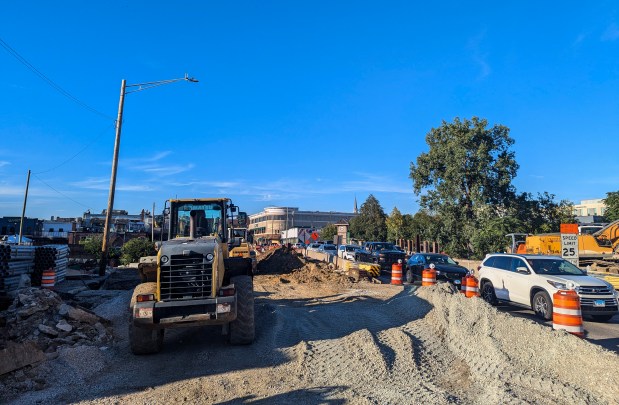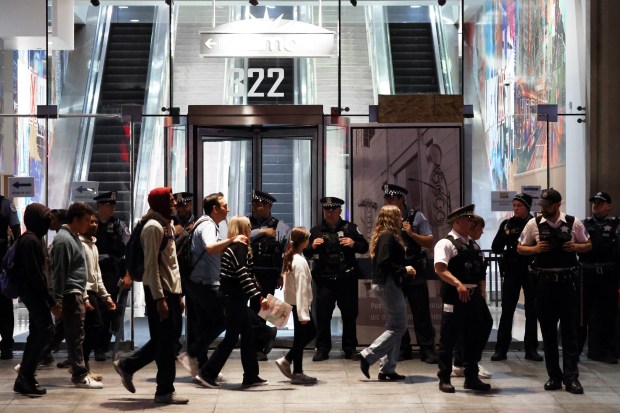Replacement of Naperville’s downtown Washington Street Bridge, originally expected to be complete by October’s end, now won’t be finished until next summer at the soonest, the project’s contractor estimates.
“If we have great weather, it would be nice to open this road up in the summer of 2025,” Mike Paine, vice president of Glendale Heights-based Dunnet Bay Construction, said Wednesday.
Construction to overhaul the decades-old bridge has been in progress since May 2023.
Federal funding administered through the Illinois Department of Transportation is covering 80% of the project’s price tag. Dunnet Bay is under contract with IDOT to perform the work, which entails the complete removal and replacement of the bridge, utility upgrades, and installation of new sidewalks and guardrails.
Work is being done alternately on the west and east sides so that one portion of the span always remains open to traffic.
Paine said the project is taking longer to finish than initially expected due to weather-related delays, crews taking on more work than they initially had been contracted for and overall “circumstances beyond the control of the contractor or the city.”
“It’s been progressing fine,” he said. “It’s a challenging project. But it is progressing.”
Crews finished pouring the east side of the new bridge deck earlier this spring, and are currently working on replacing the rest of the bridge. The goal, according to Paine, is to “get the second phase of the bridge poured” later this fall.
Should crews get the west side of the deck poured in coming months, that would allow all four lanes of the bridge to be open through the winter, according to Bill Novack, director of Naperville’s Transportation, Engineering and Development department. However, further lane closures would follow, he said.
“If they get those four lanes open over the winter, we do expect (to go) back down to one lane in each direction in the spring because they have to do the sidewalks, the parapet walls, the guardrails,” Novack said.
How work will progress through the end of this year is something Paine and Novack couldn’t say definitively.
“(There could be) potential future delays that are beyond the control of anybody involved in the contract,” Paine said.
Meanwhile, Novack said the feasibility of the west deck getting poured ahead of this winter is, in his estimation, getting “more and more remote every day, but that’s what we’re hoping for.”
The unknown for the city is less related to weather and circumstances and more centered on the crews’ rate of progress, he said. Since construction started, the city has been at odds with Dunnet Bay with regards to how fast they were completing work, Novack said.
“Their reasons (for delay), they talk about bad weather, delays on different things that have come along,” he said. “(On our end), we don’t think they put adequate resources on the project. They haven’t from the beginning and didn’t adhere to their schedule. … They fell behind early and fell further and further behind.
“We kept pointing it out to them, and they’re like, ‘We don’t have to finish until the end of next year. Don’t worry about it.’ And we were like, you’re going to get stuck.”
The city paid for cold weather concrete protection so crews could continue working over last winter, Novack said. When crews finished pouring the east side of the bridge deck a few months ago, he had hoped the project could be completed by the end of the year but delays continued, he said.
About a month and a half ago, the city met with IDOT and Dunnet Bay to talk through the delays, Novack said. Since then, he thinks crews have been “taking their rate of progress much more seriously than they have for the prior year and a half,” he said.
He added that the city has no qualms with the merit of the work. The quality “has been great,” Novack said.
IDOT spokeswoman Maria Castaneda deferred to the city in response to questions about “specific project details and/or construction schedules.” Generally, she said, “with local roads projects, IDOT’s role is to oversee federal funding, to make sure that federal funds are spent according to federal rules and that infrastructure is built to industry standards.”
Asked if the delays are incurring any additional costs for the city — which is supplying the remaining 20% of project funding not covered by federal dollars — Novack said he expects there will be but any added expenses would likely be offset by damages assessed to the contractor.
“For these contracts, if contractors are late, they can be assessed to penalty, in what are referred to as liquidated damages, for each day that they are late,” Novack said.
Paine assured that, “We’ve been working with the city to try and navigate ways to complete this work.”
Crews are going to “try to continue working as long as we can this winter,” he said.




